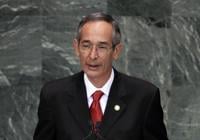ROCKVILLE, Md. (AP) — President Joe Biden and former President Donald Trump look to add to their string of victories and pad their delegate totals in Maryland on Tuesday as the presidential primary campaign enters its final weeks. Voters will also decide contested primaries in a U.S. Senate race that has further complicated Democratic efforts to keep control of the narrowly divided chamber this fall.
Maryland’s presidential primaries won’t have much of an impact on the races for the Democratic and Republican nominations, as both Biden and Trump have already been . But the Maryland ballots feature options that have proved to be stubborn irritations to both campaigns in recent contests – for Biden, it’s “ ” and for Trump, it’s former United Nations Ambassador Nikki Haley.
In the Pennsylvania primary in April, for instance, the Democratic primary saw a surge in write-in votes after activists urged voters to write “uncommitted” on the ballot in lieu of voting for Biden. In the Republican contest, , despite having dropped out of the race in early March. Haley got almost 22% of the vote in Indiana's presidential primary on May 7.
In the U.S. Senate primaries to replace , former GOP Gov. into the race has given Republicans hope of a possible pick-up in a state that hasn’t elected a Republican U.S. Senator since 1980. As a two-term governor, Hogan is the best-known and most formidable of the seven candidates vying for the GOP nomination.
The Democratic primary features 10 candidates, most notably and . Trone, who has loaned his campaign $54 million, has far outspent Alsobrooks, who had spent about $5.9 million by late April. But Alsobrooks has the support of much of the state’s Democratic establishment, including Gov. Wes Moore, U.S. Sen. Chris Van Hollen and five of the state’s six U.S. representatives whose endorsements were up for grabs. She also recently won the endorsement of The Washington Post.
Three open U.S. House seats have drawn unusually large primary fields. Six Democrats and three Republicans are running to replace retiring 11-term Democratic incumbent Dutch Ruppersberger in the 2nd District north of Baltimore City.
In the neighboring 3rd District, which includes Howard and parts of Anne Arundel and Carroll counties, 22 candidates are running in the Democratic primary, including two state senators, three state delegates and , who defended the U.S. Capitol against rioters on Jan. 6., 2021.
Sixteen Democrats and seven Republicans will appear on the ballots in the 6th Congressional District seat Trone is giving up to run for the Senate.
In Baltimore City, first-term Mayor Brandon Scott faces a dozen Democratic primary challengers, including a rematch with , his chief who resigned the office in 2010 following a corruption scandal.
Here’s a look at what to expect on Tuesday:
PRIMARY DAY
Maryland’s presidential and state primaries will be held Tuesday. Polls close at 8 p.m. ET.
WHAT’S ON THE BALLOT
The Associated Press will report vote results for the Democratic and Republican presidential primaries, as well as for contested primaries for U.S. Senate, U.S. House and Baltimore mayor. The options in the Democratic presidential primary are Biden, Dean Phillips, Marianne Williamson and “Uncommitted to any presidential candidate.” In the Republican primary, the options are Trump and Haley.
WHO GETS TO VOTE
Maryland has a closed primary system, which means that only voters registered with a political party may participate in that party’s primary. Democrats may not vote in the Republican primary or vice versa. Independent or unaffiliated voters may not participate in either primary.
DELEGATE ALLOCATION RULES
Maryland’s 95 pledged Democratic delegates are allocated according to the national party’s standard rules. Twenty-one at-large delegates are allocated in proportion to the statewide vote, as are 11 PLEO delegates, or “party leaders and elected officials.”
The state’s eight congressional districts have a combined 63 delegates at stake, which are allocated in proportion to the vote results in each district. Candidates must receive at least 15% of the statewide vote to qualify for any statewide delegates, and 15% of the vote in a congressional district to qualify for delegates in that district.
In the Republican presidential primary, all 37 delegates at stake will be awarded to the winner of the statewide vote.
DECISION NOTES
In the presidential race, Biden and Trump are the favorites in their primaries as neither candidate faces credible challenges. The first indications that they are winning statewide on a level consistent with the overwhelming margins seen in most other contests held this year may be sufficient to determine the statewide winners.
The jurisdictions to watch for signs of protest votes against either Biden or Trump are probably the state’s most Democratic-leaning areas of Baltimore City and Prince George’s and Montgomery counties in the Washington suburbs.
In the Democratic primary for U.S. Senate, the key areas to watch will be the state’s Democratic strongholds. In order to win, Trone and Alsobrooks would each need to run up the score in their respective vote-rich home counties of Montgomery and Prince George’s.
Trone is also expected to perform well in more conservative Western Maryland, which he represents in Congress. That leaves Baltimore City and the surrounding counties of Baltimore, Howard and Anne Arundel in a position to be decisive.
In the Republican primary, Hogan is well known across the state, but his vocal criticism of Trump could alienate the former president’s supporters in Western Maryland and the Eastern Shore.
In his successful 2014 primary, Hogan won the state’s population centers of Montgomery, Prince George’s, Baltimore, Anne Arundel, Howard and Frederick counties, as well as Baltimore City. He lost much of Western and Southern Maryland and the Eastern Shore. Winning in these more conservative areas on Tuesday would probably be a sign of a decisive statewide primary win for Hogan.
The AP does not make projections and will declare a winner only when it’s determined there is no scenario that would allow the trailing candidates to close the gap. If a race has not been called, the AP will continue to cover any newsworthy developments, such as candidate concessions or declarations of victory. In doing so, the AP will make clear that it has not yet declared a winner and explain why.
There are no automatic recounts in Maryland, but a candidate may request one for free if the vote margin is 0.25% of the total vote or less. Candidates may also pay for a recount in cases where the vote margin is 5% of the total vote or less. The AP may declare a winner in a race that is eligible for a recount if it can determine the lead is too large for a recount or legal challenge to change the outcome.
WHAT DO TURNOUT AND ADVANCE VOTE LOOK LIKE?
As of March 31, there were nearly 4.5 million registered voters in Maryland. Of the 4.2 million active registered voters, about 53% were Democrats and 24% were Republicans.
In the 2022 primaries, turnout was about 16% of registered voters in the Democratic primary and about 7% in the Republican primary. About 57% of Democratic primary ballots and 36% of Republican primary ballots were cast before Election Day.
As of Wednesday, a total of 372,761 ballots had been cast before the primary, about 71% in the Democratic primary and about 26% in the Republican primary. In-person early voting concluded on Thursday.
HOW LONG DOES VOTE-COUNTING USUALLY TAKE?
In the 2022 primaries, the AP first reported results at 8:42 p.m. ET, or 42 minutes after polls closed. The election night tabulation ended at 4:15 a.m. ET with about 56% of total votes counted.
ARE WE THERE YET?
As of Tuesday, there will be 62 days until the Republican ���ϳԹ��� Convention in Milwaukee, 97 days until the Democratic ���ϳԹ��� Convention in Chicago and 175 days until the November general election.








































